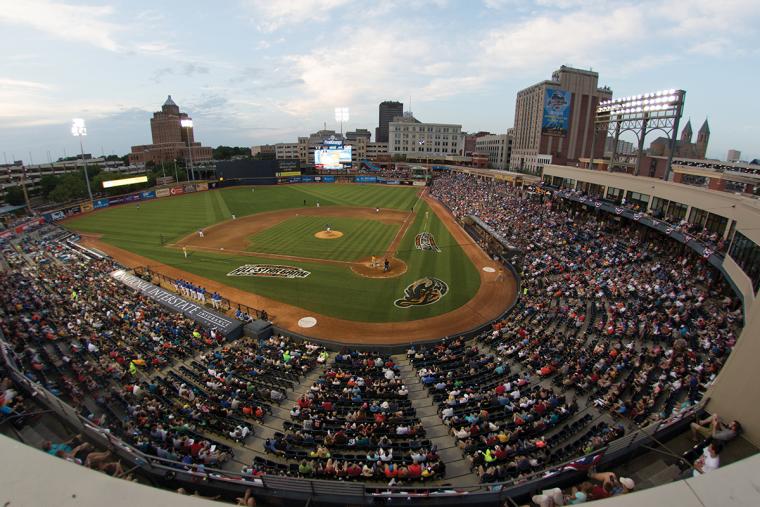
 These scenes play out across our country everyday as athletes of all ages and skill sets compete in the sports they love: The bleachers in a high school gym rumble as the teams take alternating shots, determined to win the state basketball championship; the gallery along a manicured tree-lined fairway is quieted by an alert volunteer’s sign just before the pro takes a swing to move into the tournament’s lead; family and friends jump from their sidelined folding chairs elated that the winning goal moves their soccer team into the next bracket, while sympathetically watching their opponents pack their cars (or more likely some sort of sports utility vehicle or minivan) to begin the disappointing drive home.
These scenes play out across our country everyday as athletes of all ages and skill sets compete in the sports they love: The bleachers in a high school gym rumble as the teams take alternating shots, determined to win the state basketball championship; the gallery along a manicured tree-lined fairway is quieted by an alert volunteer’s sign just before the pro takes a swing to move into the tournament’s lead; family and friends jump from their sidelined folding chairs elated that the winning goal moves their soccer team into the next bracket, while sympathetically watching their opponents pack their cars (or more likely some sort of sports utility vehicle or minivan) to begin the disappointing drive home.
In all of these instances, the power of athleticism and the spirit of competition is palpable. We take sports seriously, whether we’re the players, the fans, the events rights holders or the destination marketing organizations eager to attract the next tournament to our community. We cheer, rally, dream, breathe, eat and wave big foam fingers in the name of sports.
We participate in sporting activities because it adds value to our lives. We reap gains physically, mentally and socially, when we decide to step into the competitive arena. The decision to play requires an investment of time and resources to improve our skills, to hone our power of concentration and to learn the importance of team work. When we commit to these objectives, the positive impact on our performance and overall well-being is priceless.
Similarly, when a destination commits to attracting and securing sports events by investing staff time and marketing resources, the positive benefits to the local economy and quality of life deserve cheers and celebratory high-fives too. Whether it’s for business or leisure travel pursuits, visitor expenditures on accommodations, dining, entertainment, retail and transportation score big points for a community’s local economy.
New visitor dollars represent monies that would otherwise not be circulating throughout a city or town, if it were not for the efforts to invite and welcome them. This is the “visitor economy.” Our sports-playing and raucous-cheering visitors support local jobs, generate tax revenue and enable continued investments in our venues and services. Regardless of the outcome of their game, we, as a destination, always win and we’re incredibly grateful for the opportunity to be a part of the action.
There are many chapters in a local community’s “visitor economy” story, along with a cast of beneficiaries with equally engaging sub-plots. Three “economic impact” categories from leveraging sports events will be explored here: direct local expenditures on the previously mentioned accommodations, dining, retail, entertainment and transportation; organizations and individuals who receive the philanthropic proceeds generated by many of the events; and finally, positive added-value (a well-earned swagger and proudly displayed cachet) that elevates a community’s profile and standing as a viable sports events destination.
Similarly, the types of sports events available for a destination to pursue or to continue supporting fall into several categories: national, regional, state or local, with the added specificity of regular rotating schedules; new events with formal request for proposals; or events created by community stakeholders who never intend to host their events elsewhere. And in the case of Northeast Ohio, the pleasure of hosting a once-in-a-lifetime event, Gay Games 2014, is in a category all its own.
 Iconic, One-Off Events
Iconic, One-Off Events
So, let’s start there. In 2014, Akron and Cleveland had the honor to join an exclusive list of world wide destinations that were selected to host the highly sought-after international Gay Games, presented by the Federation of Gay Games. The domestic and international competition for the right to host the 2014 Games was fierce. Our respective community officials, stakeholders, citizens and hospitality industry leaders worked tirelessly throughout the bid process, during the Games and months following the event. A significant post-Games task was facilitating and compiling attendee spending behaviors while in Northeast Ohio; two professors from neighboring Kent State University completed the project.
Key findings – each solidifying the investment of time and resources – included a total economic impact of $52.1 million from 20,000-plus athletes and spectators; 75 percent of the 20,000+ who participated or attended the Games lived outside the Akron and Cleveland metro areas; and 64 percent of local participants said they would have traveled outside Northeast Ohio to participate in the Gay Games, taking their local spending of $8.4 million to another region.
Additionally, northeast Ohio stakeholders (in partnership with our Convention & Visitors Bureau colleagues around the state) have been working on initiatives to excel the momentum created by the Games. For any destination, using past successes to create new opportunities is a vital strategy; a strategy that must measure direct spending, gifts from proceeds and the pride of hosting the event.
Signature Destination Sports Events
Communities across the nation have events that are theirs and theirs alone. Regardless of the sport, the natural and man-made venues they tout or the radius from which participants and spectators travel to attend, all of the associated expenses of traveling make a welcome and regular impact on the local economy. Whether these tournaments and contests organically found a permanent home over the decades or were the original creations of local residents, a destination is obligated (and should be happy with the responsibility) to support and to nurture their growth. Signature events provide opportunities to up-sell a city’s sights, sounds and experiences before and/or after the main event.
In cooperation with the event rights holders, the destination marketing organization must develop and employ marketing strategies to capture additional visitor expenditures. In Greater Akron, visitors are encouraged to plan an extended summer trip during the FirstEnergy All-American Soap Box Derby World Championships. The Depression-era program, Works Progress Administration built the Derby’s permanent home in 1936 and since that time welcomes the best racers from around the globe to race their very best on Derby Downs.
Considering the initial investment made by racers, their families and friends to arrive in Akron, it’s logical to persuade them to stick around to enjoy area attractions, restaurants, outdoor recreation and vibrant arts and culture offerings. If they do, more revenue hits the hospitality industry partners’ bottom lines. Like the Derby, we encourage pre/post visitation around the World Golf Championships Bridgestone Invitational and the Akron Children’s Hospital Akron Marathon Race Series, each generating millions of dollars for our economy. The Northern Ohio Golf Charities Foundation grants nearly $1 million annually to area non-profits and eligible charities, while the Marathon generated nearly $500 thousand in donations for the Hospital in 2016.
 Youth, High School and Collegiate Sports Events
Youth, High School and Collegiate Sports Events
These tournaments and exhibitions are the bread and butter for communities with an established or emerging sports marketing strategy. Youth sports are as diverse as the kids who strap on helmets and pick up racquets. High school athletics provide myriad opportunities to bid on regional qualifying events or the state championships that follow them.
More likely to need accommodations, collegiate sports generally require athletes and their followers to travel some distance to participate. Depending on the geography, these overnight visits may or may not factor into their travel plans, but there’s a reasonable chance a formal room block will be required to house a decent percentage of the attendees. With these pieces of business, an early arrival or a delayed departure will enhance visitors’ experiences. A destination’s willingness to arrange custom tours or create self-guided itineraries, while highlighting the best things to do, see and eat, will make visitors seriously consider spending more time (and money) with the city.
For many of the high school teams and families that travel from around the U.S. to Greater Akron every spring for The King James Shooting Stars Classic, their time away from home becomes a mini vacation and they plan ahead accordingly. (For the record, LeBron’s high school coach Dru Joyce, II established the Akron tournament, which was just renamed the Dru Joyce Shooting Stars Classic after 11 successful years; it was renamed to honor LeBron’s coach and his son, Dru Joyce, III.) A personalized digital concierge, created by the Akron/Summit CVB, was available in advance of the tournament for coaches, athletes and family members to explore. The King James Shooting Stars Classic welcomed 600-plus teams this year and generated more than $5 million in tournament-related impact. Their additional spends to stay and kick-around Greater Akron were icing on the proverbial cake.
Newly-Identified & Biddable Sports Events
Destination marketing organizations across the country would be lying if they denied wanting to be on the ground floor of hosting non-traditional sports events. These can include sports being played just off the edge of the mainstream radar or activities experiencing a resurgence in popularity. Spikeball, disc golf, pickleball, table tennis and eSports are a few among a growing list of specialty sports destinations need to consider. An important resource for identifying these opportunities are local athletes.
Sampson Dubina, Ohio’s top-ranked table tennis player lives in Akron and is more aggressively promoting state, national and international tournaments in his hometown. In-kind and modest financial assistance from the Akron/Summit CVB has allowed him to raise the profile of his events, attract more players and boost the economic impact to our city.
Similarly, the second annual Cuyahoga Falls Kayak Race was held in April with the support of city officials, local organizers and a robust network of residents posting, tweeting and YouTubing the increasingly popular rapids on the Cuyahoga River. It usually takes considerable research and networking to become familiar with these “local influencers,” but it’s an investment with positive returns.
Opportunities to secure traditional sports also fall into this category. Established tournaments (i.e., lacrosse, soccer, softball, futsal, track & field) often spawn new events due to their popularity, adding another tier of biddable events. The best advice for success in this category is to methodically turn over every possible stone – you’re sure to find some hidden gems you didn’t realize were right within your reach.
The Power & Reach of Sports Events
The strength of a community’s visitor economy determines how solid the foundation upon which its hospitality industry rests. When sports events are held in cities of all sizes, the benefits are many, including the expenditures on comfortable pillows to rest tired heads, meals to satisfy the hunger of competition and activities to create memories beyond those made during the game.
Developing a strategy to maximize your community’s sports venues, while deliberately incorporating your visitor assets will enable you to capture a portion of this increasingly lucrative market. Destinations have a large number of things in common when sports events planners begin the process of selecting a site for their next tournament or exhibition. Narrowing their choices to your community requires creativity and tenacity.
Like the athletes taking the field or catching their breath during a brief time-out on the court, you must possess the same determination and stamina to successfully win in the sports events market. You and your potential sports events planners are on the same team. The positive economic impact of their events is great, but don’t ever forget to express your thanks and appreciation for their business, partnership and belief in your community. SDM

